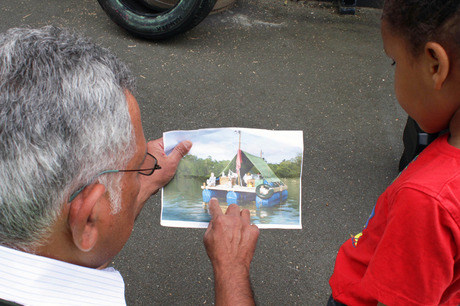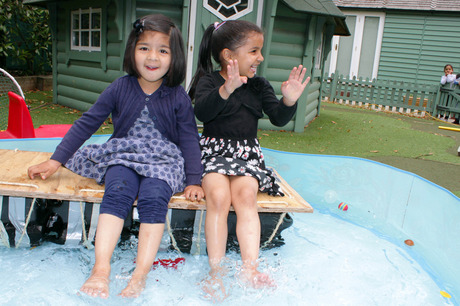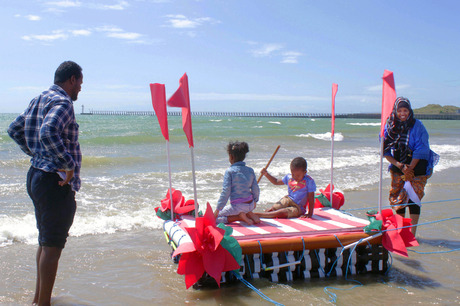learning opportunities and discussions about the wider world. The
nursery's artist-in-residence Rosie Potter explains.

At Greenfield's Children's Centre in Southall, 2015 has been a year when children's expressive curiosity has centred on the alliterative pairing of boats and bees.
Working together with fellow artist-in-residence Kirstie Reid - both of us from Wimbledon College, University of the Arts London - we took the children's interest in travel and natural history as a starting point for our creative engagement. We observed, in particular at this time, their fascination with water transport and insect life.
Initially, this raised questions about floating, sinking, natural habitats, flight and survival. It then led to considerations of wider global issues, including the devastating prospect of a world without bees. Up for discussion, too, was the topical issue of thousands of refugees trying to cross the seas in unreliable vessels to escape persecution.
These were big themes for pre-school children to take on board. However, driven by their inherent desire to learn, together with a collective pioneering spirit, they worked hard to develop valuable innovative strategies and thought processes to help them unravel some of the complex and difficult problems facing our environment today.
The children's intense interest in exploring a range of materials and tools, as well as some practical making skills, enabled them to embark confidently upon an ambitious project. Its aim involved the building of a seaworthy craft, able to take passengers and be launched successfully at the seaside in Littlehampton later in the year.
IN STAGES

In the pre-production stages, the children were initially involved in a series of small experiments in basic physics, exploring:
- the sinking/floating potential of a wide range of materials - 'wood', 'cork', 'plastic'
- the rationale for buoyancy in both fresh and salt water - 'when it's got no bottom it sinks', 'if something heavy is in the boat it will sink', 'if it's not heavy it will float', 'the water made it float', and
- the impact of the failure of objects to stay afloat - 'it's sinking', 'all the people sink like this', 'all the people are making it heavy and they can't swim', ' the people are falling off the boats because there are too many of them'.
Then children thought about ways in which an object might move through water - for example: 'use magic', 'propeller', 'electricity', 'huff and puff and blow, it will sail'.
Basic boats were then made from cartons, ice moulds, cardboard and foam rubber, using rubber bands, detergent, wind, heat and paddles as propellants - some of these experiments were naturally more successful than others, but at all times the details were closely examined and logged.
Just before half term, a request went out to families to collaborate with their children on the design of a boat. Parents, grandparents and extended families responded positively, becoming keenly involved in the creation and presentation of elaborate designs, original drawings and ideas. This resulted in the final impressive submission of more than 50 amazing model boats; most ingeniously made from everyday materials found around the house.
The children took their time to select one model on which to base their full-scale craft, and after half term the chosen design went straight into production.
At this stage the children needed to select appropriate materials, setting weight against buoyancy, making careful calculations of distances, volume, density and scale, through the viewing of plans and photographs, by taking accurate measurements and working on experimental drawings.
The next stage involved manufacturing airtight flotation blocks, cutting out a platform and building a prototype raft to test in the paddling pool at the nursery.
Hand co-ordination skills were also required for roping, drilling, cutting, taping, sawing and screwing to combine all the different elements together.

The wider themes continued to be explored through discussion in philosophy groups. The children also clearly enjoyed exploring through their play the rich imaginative potential of references to distant travel in poetry, rhymes, songs and maps, while musing on more abstract universal themes. These musings included the following:
- 'I don't know where the sun goes when the stars go up ...'
- 'The stars are still there when it's day; it's just too bright to see them.'
- 'When the sun comes out, we can't see the moon.'
- 'Sun at night is lighting up the moon.'
- 'The moon is half, the other bit has cracked.'
- 'When there's a lot of wind the moon can fly.'
Children also consulted weather forecasts around this time to determine the conditions for the launch at Littlehampton: 'rain early in the morning, then sun and wind in the afternoon, with an incoming tide' - an almost ideal scenario!
THE LAUNCH

On Tuesday 7 July, a group of 150 children, parents, teachers and artists arrived in three coaches at Littlehampton Museum's historic Manor House for a photo opportunity with their splendid raft and a selection of model boats.
The entire party formed a procession led by the museum's curator, Juliet Thomas, with some athletic dads carrying the raft through Littlehampton town centre, where both raft and models were much admired by the local community.
The sun reached its height as we approached the riverside walkway and paraded alongside the beautiful River Arun in the company of swans.
Many of the children had never seen the sea before, so there was much excitement in the group as we approached the beach, and children ran ahead to catch their first glimpse of glittering unbounded water before sharing a picnic lunch on the sands.
Then came the ultimate challenge. The local lifeguards directed us to the location on the beach designated for the launch of the raft. The big question for everyone was: would our raft be seaworthy? Would it float and be able to carry passengers?
The answer turned out to be a resounding YES! The raft was buoyant, well balanced and easily capable of carrying groups of six children at any one time.
Throughout the afternoon, as the raft drifted repeatedly out to sea in the sun and wind and was swept back to the beach on the waves of the incoming tide, some children squealed with joy and delight while others quietly contemplated the vastness of the landscape.
One child remarked, 'The sea is very deep, so you can't reach it.'
His friend responded, 'Real water is when there's lots of sea ... the sea goes on forever.'
And another said, 'People need boats to get to the other side.'
A selection of the model boats will be exhibited in the Library Gallery at Wimbledon College, University of the Arts, London, in October 2015.
Rosie Potter is senior lecturer on the BA Fine Art: Print + Time-Based Media Course, at Wimbledon College, University of the Arts, London, and artist-in-residence and community governor at Greenfields Children's Centre, Southall, r.potter@wimbledon.arts.ac.uk.
MORE INFORMATION
Head of centre at Greenfields and Havelock Children's Centres is Ellie Larkin, who can be contacted on 020 8813 8079. For more information, see www.greenfieldschildren.com.









